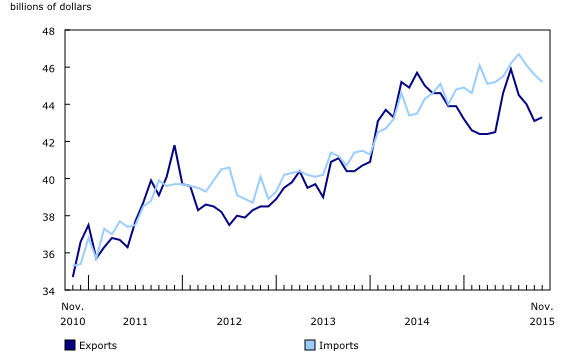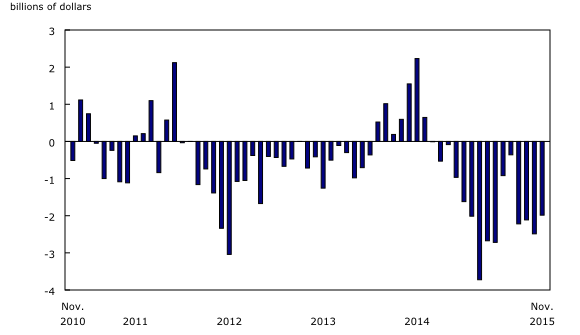Canadian international merchandise trade, November 2015
Archived Content
Information identified as archived is provided for reference, research or recordkeeping purposes. It is not subject to the Government of Canada Web Standards and has not been altered or updated since it was archived. Please "contact us" to request a format other than those available.
Released: 2016-01-06
Canada's imports decreased 0.7% in November and exports increased 0.4%. Import volumes declined 1.6% while prices increased 0.9%. For exports, volumes were up 0.7% while prices declined 0.4%.
As a result, Canada's merchandise trade deficit with the world narrowed from $2.5 billion in October to $2.0 billion in November.
Exports to the United States increase, while trade with non-US countries decreases
Exports to the United States rose 1.3% to $32.5 billion in November, while imports edged down 0.1% to $30.4 billion. Consequently, Canada's trade surplus with the United States widened from $1.7 billion in October to $2.1 billion in November.
Exports to countries other than the United States declined 2.2% to $10.7 billion in November. The declines were widespread, led by the United Kingdom and Germany. Meanwhile, imports from countries other than the United States decreased 2.1% to $14.8 billion. Lower imports from Switzerland and China were moderated by higher imports from Japan and Saudi Arabia. As a result, Canada's trade deficit with countries other than the United States narrowed from $4.2 billion in October to $4.1 billion in November.
Import volumes decline in most sections
Total imports declined 0.7% to $45.2 billion in November. Imports fell in 7 of 11 sections, with the largest declines in electronic and electrical equipment and parts as well as energy products. Year over year, total imports increased 2.8%.
Imports of electronic and electrical equipment and parts decreased 2.9% to $5.1 billion. The main contributor was communications and audio and video equipment, down 9.1% to $1.6 billion. Overall, volumes declined 3.7% while prices increased 0.8%.
Imports of energy products fell 6.4% to $2.1 billion, the lowest import value since August 2004. In November, overall volumes were down 8.3% while prices increased 2.1%. Imports of crude oil and crude bitumen were down 9.1% to $919 million, the fifth consecutive monthly decrease.
Imports of consumer goods declined 1.0% to $9.8 billion. Widespread decreases throughout the section were led by pharmaceutical and medicinal products (-2.3%), alcoholic beverages (-8.1%) and clothing, footwear and accessories (-1.4%). Overall, volumes were down 1.9% while prices increased 0.9%.
These declines were moderated by a 2.5% increase in industrial machinery, equipment and parts to $4.5 billion. There were higher imports of other general-purpose machinery and equipment (+7.7%), mainly turbines and turbine generator set units. For the section as a whole, prices increased 1.3% and volumes rose 1.2%.
Motor vehicles and parts lead increase in exports
Total exports rose 0.4% to $43.3 billion in November, following three consecutive declines. There were increased exports of motor vehicles and parts; metal ores and non-metallic minerals; and forestry products and building and packaging materials. These gains were partially offset by lower exports of energy products and consumer goods. Exports excluding energy products rose 1.6% in November. Year over year, total exports were down 1.6%.
Exports of motor vehicles and parts rose 5.9% to $7.9 billion. The main contributor was passenger cars and light trucks, up 7.7% to $5.4 billion. Overall, volumes rose 4.7% and prices increased 1.1%.
Exports of metal ores and non-metallic minerals increased 20.4% to $1.8 billion on higher volumes. Exports of copper ores and concentrates almost doubled to $482 million in November.
Forestry products and building and packaging materials exports were up 5.5% to $3.5 billion on higher volumes. Widespread increases in exports throughout the section were led by lumber and other sawmill and millwork products (+8.6%) and pulp and paper stock (+6.0%).
Partially offsetting these increases, exports of energy products fell 6.6% to $5.9 billion, the lowest export value since May 2009. In November, exports of refined petroleum energy products (-30.8%) and natural gas (-17.8%) decreased. For the section as a whole, volumes were down 3.5% and prices declined 3.2%.
Exports of consumer goods declined 4.5% to $6.0 billion on lower volumes. Exports of pharmaceutical and medicinal products fell 20.7% to $832 million. Exports of other food products were down 10.2% to $1.3 billion, on lower exports of lentils and peas.
Revisions to October imports and exports
Revisions reflect initial estimates being updated or replaced with administrative and survey data as they became available, as well as amendments made for late documentation of high-value transactions. Imports in October, originally reported as $45.7 billion in last month's release, were revised to $45.6 billion with the current month release. Exports, originally reported as $43.0 billion in last month's release, were revised to $43.1 billion.
Note to readers
Merchandise trade is one component of Canada's international balance of payments (BOP), which also includes trade in services, investment income, current transfers as well as capital and financial flows.
International trade data by commodity are available on both a BOP and a customs basis. International trade data by country are available on a customs basis for all countries, and on a BOP basis for Canada's 27 principal trading partners (PTPs). The list of PTPs is based on their annual share of total merchandise trade—imports and exports—with Canada in 2012. BOP data are derived from customs data by making adjustments for factors such as valuation, coverage, timing and residency. These adjustments are made to conform to the concepts and definitions of the Canadian System of National Accounts.
For a BOP versus customs-based data conceptual analysis, see "Balance of Payments trade in goods at Statistics Canada: Expanding geographic detail to 27 principal trading partners."
Data in this release are on a BOP basis, seasonally adjusted and in current dollars. Constant dollars are calculated using the Laspeyres volume formula (2007=100).
For information on seasonal adjustment, see Seasonally adjusted data – Frequently asked questions.
Revisions
In general, merchandise trade data are revised on an ongoing basis for each month of the current year. Current year revisions are reflected in both the customs and BOP based data.
The previous year's customs data are revised with the release of the January and February reference months as well as on a quarterly basis. The previous two years of customs based data are revised annually and are released in February with the December reference month.
The previous year's BOP based data are revised with the release of the January, February, March and April reference months. To remain consistent with the Canadian System of macroeconomic accounts, revisions to BOP based data for previous years are released annually in December with the October reference month.
Factors influencing revisions include late receipt of import and export documentation, incorrect information on customs forms, replacement of estimates produced for the energy section with actual figures, changes in classification of merchandise based on more current information, and changes to seasonal adjustment factors.
For information on data revisions for crude oil and natural gas, see "Revisions to trade data for crude oil and natural gas."
Revised data are available in the appropriate CANSIM tables.
Real-time CANSIM tables
Real-time CANSIM table 228-8059 will be updated on January 15. For more information, consult the document Real-time CANSIM tables.
Next release
Data on Canadian international merchandise trade for December 2015 will be released on February 5, 2016.
Products
Customs based data are now available in the Canadian International Merchandise Trade Database (65F0013X). From the Browse by key resource module of our website, choose Publications.
The November 2015 issue of Canadian International Merchandise Trade, Vol. 69, no. 11 (65-001-X), is also available from the Browse by key resource module of our website under Publications.
Contact information
For more information, contact us (toll-free 1-800-263-1136; 514-283-8300; STATCAN.infostats-infostats.STATCAN@canada.ca).
To enquire about the concepts, methods or data quality of this release, contact Nita Boushey (613-404-4965; nita.boushey@canada.ca), International Accounts and Trade Division.
- Date modified:





